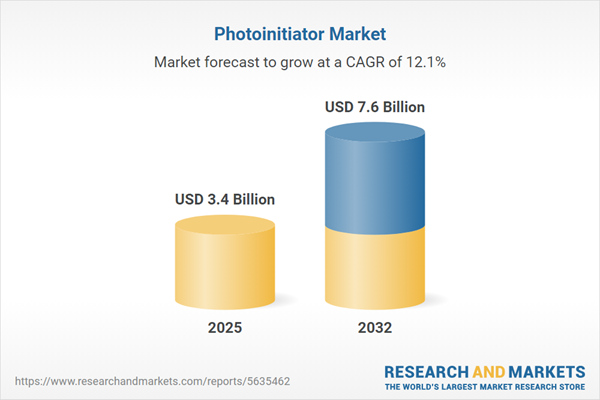Speak directly to the analyst to clarify any post sales queries you may have.
Senior leaders seeking insights into the photoinitiator sector will find an evolving landscape shaped by innovation, operational complexity, and strategic opportunity. As demand grows for faster, more sustainable curing technologies across industrial applications, market participants face changing regulatory and trade environments, highlighting the importance of informed decision-making and risk management.
Photoinitiator Market Snapshot
The Photoinitiator Market grew from USD 3.04 billion in 2024 to USD 3.40 billion in 2025. It is expected to continue growing at a CAGR of 12.14%, reaching USD 7.60 billion by 2032. This robust growth reflects increased adoption of photoinitiator-enabled coatings, adhesives, and inks amid intensifying demands for process efficiency, sustainability, and regulatory compliance across manufacturing verticals. Regional expansion, the evolution of energy-efficient curing platforms, and a focus on supply chain agility are actively reshaping competitive priorities for stakeholders. Senior executives are called to assess shifting dynamics and capitalize on opportunities within this fast-changing marketplace.
Scope & Segmentation
The research provides actionable scope across key segmentation and technology trends, helping stakeholders align strategies and investments:
- Application: Adhesives, coatings, and printing inks—each segment carries unique challenges around performance, regulatory compliance, and process integration.
- Type: Type I chemistries (acyl phosphine oxides, alpha hydroxy ketones); Type II options (benzophenone, thioxanthone) for tailored photochemical activation profiles.
- Technology: LED curing, UV curing, and visible light curing—all enable different energy savings, equipment requirements, and process safety protocols.
- End Use Industry: Automotive, electronics, and medical sectors with distinct specification needs including thermal resistance and biocompatibility.
- Form: Liquid, powder, and solid—each with implications for transport, handling, and formulation efficiency.
- Region: Americas (North America and Latin America), Europe, Middle East & Africa, and Asia-Pacific—each defined by regulatory outcomes, end-user trends, and innovation ecosystems.
- Countries: Detailed scope covers United States, Canada, Mexico, Brazil, United Kingdom, Germany, France, China, India, Japan, Australia, South Korea, Indonesia, and several others spanning every key growth geography.
- Leading Companies: BASF SE, Evonik Industries AG, Merck KGaA, Arkema S.A., Allnex B.V., Dow Inc., IGM Resins B.V., Johnson Matthey PLC, Spectra Group Ltd, Zeneka Ltd.
Key Takeaways for Senior Leadership
- The Photoinitiator Market is rapidly evolving with new chemistries and curing methodologies, enabling deeper curing and higher production throughput.
- Regulatory pressures are intensifying the shift toward low-emission and energy-efficient curing systems, increasing the strategic value of compliant photoinitiator solutions.
- Regional dynamics significantly influence product development strategies; Europe and North America emphasize sustainability initiatives, while Asia-Pacific capitalizes on industrial expansion and rapid device manufacturing.
- Raw material sourcing strategies are adapting to manage costs, ensure resilience, and address shifting trade regulations—including a recent focus on supply chain diversification and localized production.
- Collaboration between photoinitiator manufacturers and equipment suppliers is fueling integrated product development, leading to improved performance and more rapid validation in end-use applications.
- Innovation portfolios increasingly reflect a commitment to bio-based formulations, reduced toxicity, and solutions tailored to diverse industry specifications.
Tariff Impact on the Photoinitiator Market
The introduction of new U.S. tariffs in 2025 has directly affected procurement and supply chain models for photoinitiator stakeholders. Increased duties on raw materials from key manufacturing hubs are prompting shifts toward sourcing from low-tariff regions and renegotiating long-term contracts. Companies are also investing in backward integration and exploring alternative chemistries using locally available precursors. Effective supply chain recalibration and strategic partnerships are now critical for maintaining market stability and competitive pricing strategies.
Research Methodology & Data Sources
This report leverages a robust research design that combines expert interviews, targeted surveys, and proprietary quantitative analysis. Multiple secondary sources—including journals, patent literature, regulatory filings, and white papers—support trend benchmarking and market contextualization. Rigorous validation and cross-functional review protocols help ensure reliability and strategic relevance in all analytical findings for the photoinitiator market.
Why This Report Matters
- Enables senior decision-makers to identify actionable growth opportunities and respond proactively to regulatory, technological, and supply chain challenges.
- Facilitates strategic alignment through comprehensive coverage of core segmentation, regional innovation ecosystems, and evolving end-user needs.
- Empowers organizations to benchmark best practices and drive operational excellence in photoinitiator development, sourcing, and deployment.
Conclusion
The photoinitiator sector continues to transform, shaped by innovation, collaboration, and adaptive supply strategies. Executives equipped with comprehensive insights will position their organizations to lead amidst complexity and unlock sustained competitive advantage.
Additional Product Information:
- Purchase of this report includes 1 year online access with quarterly updates.
- This report can be updated on request. Please contact our Customer Experience team using the Ask a Question widget on our website.
Table of Contents
3. Executive Summary
4. Market Overview
7. Cumulative Impact of Artificial Intelligence 2025
List of Figures
Samples

LOADING...
Companies Mentioned
The key companies profiled in this Photoinitiator market report include:- BASF SE
- Evonik Industries AG
- Merck KGaA
- Arkema S.A.
- Allnex B.V.
- Dow Inc.
- IGM Resins B.V.
- Johnson Matthey PLC
- Spectra Group Ltd
- Zeneka Ltd
Table Information
| Report Attribute | Details |
|---|---|
| No. of Pages | 196 |
| Published | October 2025 |
| Forecast Period | 2025 - 2032 |
| Estimated Market Value ( USD | $ 3.4 Billion |
| Forecasted Market Value ( USD | $ 7.6 Billion |
| Compound Annual Growth Rate | 12.1% |
| Regions Covered | Global |
| No. of Companies Mentioned | 11 |








